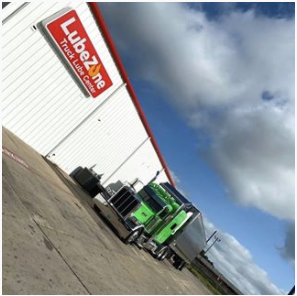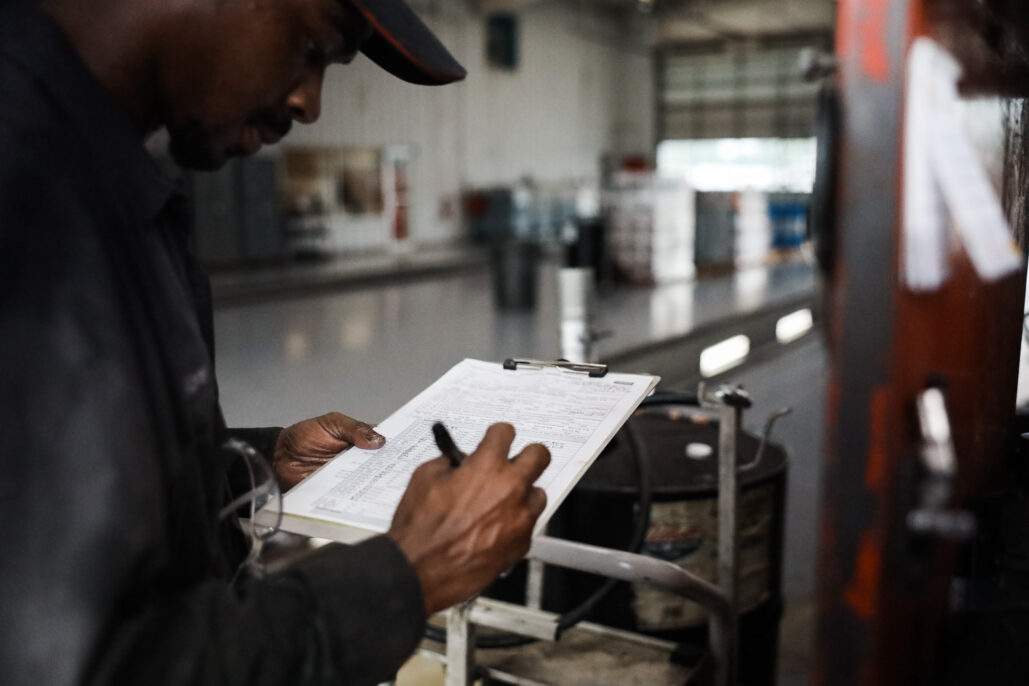
Signs It’s Time to Replace Your Semi Truck Battery
June 26, 2025Being an owner-operator is one of the most intensive jobs you can do in the trucking industry. Not only are you on the road, responsible for hauling freight and meeting deadlines, but you’re also responsible for all aspects of daily operation — including logistics, administrative tasks, and truck maintenance. DOT inspections are part of the job for every owner-operator, and staying informed on the current truck inspection requirements is essential.
Whether hauling across state lines or running regional freight, having a DOT inspection checklist ensures you remain compliant. After all, should you fail an inspection, the DOT may take you OOS immediately and impose hefty fines, throwing a metaphorical wrench in your schedule.
Understanding the different DOT inspection levels, knowing what documents you must carry, and running routine checks on your rig help ensure your next trip runs smoothly. The better prepared you are, the faster the inspection, and the quicker you’re back behind the wheel.
This guide covers everything owner-operators need to know, including a practical DOT inspection checklist, common violation pitfalls, and expert tips to help you pass inspection. Avoid delays, stay compliant, and keep your truck rolling with these tips from LubeZone Truck Lube Center — home to the 40-minute oil change and your spot for all semi-truck preventative maintenance.
What You Need to Know About DOT Inspections
DOT inspections are regulated by the Federal Motor Carrier Safety Administration (FMCSA) and are mandatory for all American trucks. These inspections cover a wide range of components regarding the truck and driver safety. Inspectors want to see that your rig is in top shape and that you’re up to all current safety regulations.
These inspections may occur at a weigh station, roadside, or scheduled compliance review. Not only do officials review the physical aspects of your truck, but they’ll also take a careful look at driver documentation and behavior. If you fail an inspection, the DOT may take you out of service until you rectify any noted issues. For this reason, staying prepared is crucial.
Why DOT Inspections Matter
DOT inspections are essential for keeping trucks, drivers, and roadways safe. Even one missed maintenance issue can cause an accident on the road, leading to serious accidents, steep fines, or extended downtime. According to the FMSCA, maintenance problems contribute to 40% of all semi-truck accidents yearly. Key identified factors include brake failure, tire problems, and improperly loaded trailers.
Nearly 5,000 Americans die annually in semi-truck vehicle collisions, and another 155,000 sustain serious injury (IIHS). These accidents cost billions of dollars in damages and injuries, with estimates ranging from $20 billion to $340 billion every year.
Fulfilling all portions of the DOT inspection checklist can minimize the risk of such accidents, increase your truck’s efficiency, and lead to safer road conditions for all. For owner-operators, these inspections also impact your Compliance, Safety, and Accountability (CSA) score, which can influence insurance rates, DOT audits, and your ability to get loads. A clean inspection record boosts your reputation and shows brokers and carriers you’re serious about safety.
Who Conducts DOT Inspections
DOT inspections are usually conducted by certified state troopers, Department of Transportation officers, or CVSA-certified inspectors at:
- Weigh stations
- Rest areas
- Inspection sites
- Roadside pullovers
In some cases, inspections may also occur during a compliance review at a motor carrier’s place of business.
How Often Are DOT Inspections Required?
DOT inspections are legally required every 12 months for commercial vehicles weighing over 10,000 lbs. These usually take place at a shop or service center. There’s no fixed schedule for a roadside inspection — they’re often random.
Beyond that, roadside inspections can happen anytime you’re stopped or flagged for review. Trucks with prior violations or poor CSA scores are also more likely to be pulled for repeat inspections.
Understanding the Different Types of DOT Inspections
DOT inspections come in multiple levels. Knowing what each one covers helps you prepare and respond with confidence. Whether you’re pulled in for a full inspection or just a quick document check, understanding truck inspection requirements gets you back on the road faster.
Below, all the information for the DOT inspection levels is explained.
Level 1: Full Driver & Vehicle Inspection
This is the most thorough inspection and the one most likely to occur during a CVSA Roadcheck or at weigh stations. It includes a complete review of:
- Driver credentials (CDL, medical card, HOS logs, inspection reports)
- Complete walk-around and under-vehicle inspection
- Brake systems, steering, suspension, tires, lighting, and more
- Cargo securement and hazardous material handling (if applicable)
Passing a Level 1 inspection with no violations earns you a CVSA decal, which is good for 3 months, and signals your truck has already been checked.
Level 2 & 3: Common Roadside Inspections
These are the most frequent inspections owner-operators encounter on the road.
- Level 2 is a walk-around inspection focusing on vehicle components visible without getting underneath the truck. Inspectors also verify logbooks and licensing.
- Level 3 is a driver-only inspection, focusing solely on your documents: CDL, medical card, ELD logs, inspection history, and supporting records.
Special Levels 4-6: Less Common Scenarios
These inspections are rarer but still important to know:
- Level 4: A one-time inspection targeting a specific item, often for research or enforcement studies.
- Level 5: A complete vehicle inspection without the driver present, usually done at a terminal or during audits.
- Level 6: Specific to radioactive materials and includes enhanced security, documentation, and vehicle checks.
While most drivers will never encounter Levels 4–6, staying informed keeps you one step ahead if you’re ever selected.
DOT Inspection Checklist
Having a clear DOT inspection checklist is one of the best tools an owner-operator can use to stay compliant. Whether you’re preparing for your annual inspection or want to be ready for a roadside stop, this list will help you stay organized and inspection-ready.
Driver Readiness & Required Documents
Inspectors will start by verifying that you are qualified to operate the vehicle. That means checking your credentials, logs, and safety records. Here’s what to have ready:
CDL, logbooks, med card, HOS records
- Valid Commercial Driver’s License (CDL) — no restrictions, up-to-date.
- Medical Examiner’s Certificate (Med Card) — current and readily available.
- Hours-of-Service Logs — digital or printed logs for the past 7 days via a compliant ELD.
- ELD malfunction procedures — if your device fails, be ready to explain and show backup paper logs.
- Vehicle Inspection Reports — daily pre- and post-trip inspection records.
- Skill Performance Evaluation (SPE) Certificate — if applicable (for limb impairments).
Vehicle Systems to Inspect
Inspectors will walk around your truck and trailer (and sometimes go underneath) looking for mechanical issues and safety hazards. These are the core truck inspection requirements:
Brakes, tires, lights, wipers, mirrors, leaks
- Brakes: Check for worn pads, air leaks, cracked hoses, and proper adjustment.
- Tires: Proper inflation, 2/32″ tread depth minimum on steer tires, no bulges or exposed cords.
- Lights & Reflectors: Functioning headlights, brake lights, turn signals, and clearance lights.
- Windshield Wipers: Blades are intact and working, and the washer fluid is topped off.
- Mirrors: Secure, clean, and correctly aligned.
- Leaks: No visible fuel, oil, coolant, or brake fluid leaks.
- Suspension & Steering: No cracked leaf springs, loose components, or damaged U-bolts.
- Horn & Dash Indicators: Fully functional and alerting as expected.
Emergency Equipment & Safety Items
Every CMV must carry working emergency and safety supplies. Missing any of these is an easy violation, so check them often.
- Fire Extinguisher: Fully charged, mounted, and rated for truck use.
- Warning Triangles: Three reflective triangles in good condition.
- Spare Fuses: Extra fuses for all circuits unless circuit breakers are in use.
- Hazmat Response Guidebook: Required if hauling hazardous materials.
- Seatbelts: Fully functional and not frayed or damaged.
Ensure all safety gear is accessible and not buried under cargo or loose equipment.
Avoiding Common DOT Inspection Violations
Most DOT inspection violations are completely avoidable with regular maintenance and daily diligence. Understanding the most common violations and how to prevent them is essential to staying compliant and on the road.
Top 5 Violations and How to Prevent Them
According to the FMCSA, these are the most commonly cited roadside violations. How can they be prevented?
- False Report of Driver’s Record of Duty Status – 49 CFR 395.8(e).
- Stay in Compliance: Read the Interstate Truck Driver’s Guide to Hours of Service.
- No Record of Duty Status (ELD Required) – 49 CFR 395.8(a).
- Stay in Compliance: Read the FMCSA’s complete guide on the ELD homepage.
- Inoperable Required Lamp – 49 CFR 393.9.
- Stay in Compliance: Check out the Motor Carrier Safety Planner to learn about vehicle lighting requirements.
- Operating a Commercial Motor Vehicle (CMV) Without a Commercial Driver’s License (CDL) – 49 CFR 383.23(a)(2).
- Stay in Compliance: Keep a valid CDL and learn more about driver qualifications.
- Operating a Commercial Motor Vehicle (CMV) Without Proof of a Periodic Inspection – 49 CFR 396.17(c).
- Stay in Compliance: Learn more about truck inspection requirements.
Maintenance Habits That Pay Off at Inspection Time
Other common inspection violations include:
- Brake Violations (worn brake pads, out-of-adjustment slack adjusters, or air leaks)
- Tire Violations (low tread depth, mismatched tires, or visible damage)
- Light & Reflector Violations (burned-out bulbs and broken or missing reflectors)
- Cargo Securement Violations (loose straps, frayed tie-downs, and shifting loads)
These habits help catch problems before inspectors do:
- Schedule regular preventative maintenance. Stick to a maintenance schedule that includes oil changes, brake inspections, and system checks.
- Conduct daily pre-trip inspections. Before starting your day, walk around your vehicle and check all lights, fluids, and moving parts.
- Document everything. Keep records of inspections, repairs, and maintenance up to date and easily accessible.
- Fix small issues immediately. A burned-out light or minor leak might not seem urgent — until it causes a delay or violation.
- Use trusted service centers. Visit reputable maintenance shops like LubeZone, which specializes in fast, high-quality service for owner-operators.
Tips for a Smooth DOT Inspection
Here are a few proven strategies to help your next inspection go as smoothly as possible.
- Stay organized: Keep all required documents — CDL, medical card, inspection reports, and HOS logs — in a single, easy-to-access folder or binder.
- Know your equipment: Be able to demonstrate your ELD functions, explain your cargo securement method, and point out emergency equipment if asked.
- Review your inspection history: Know what violations you’ve had in the past and be prepared to show how you’ve corrected them.
- Stay current: Regulations evolve. Stay updated on FMCSA rules, ELD requirements, and any inspection procedure or criteria changes.
Proactive drivers pass inspections more efficiently, avoid unnecessary downtime, and maintain a strong reputation with enforcement officers and carriers.
DOT Inspection FAQs
Even experienced drivers question what to expect during a DOT inspection since regulations are ever-changing. These frequently asked questions cover some of the most common concerns owner-operators have on the road.
What Happens If You Fail a DOT Inspection?
If you fail a DOT inspection, the result depends on the severity of the violation. Minor infractions may lead to warnings or citations, but serious violations — like brake defects or falsified logs — can result in being placed out of service (OOS).
You typically have 15 days to submit proof that the issues have been corrected. Failing to do so can lead to further penalties and negatively impact your CSA score.
Are Roadside Inspections Always Random?
Roadside inspections can be random, but specific factors often trigger them. These include visible mechanical issues (like a broken light), expired license plates, erratic driving, or poor inspection history tied to your DOT number.
Carriers with strong safety records and drivers with recent clean inspections are less likely to be pulled over.
Does Every Driver Need to Carry a DOT Log?
Yes, unless you qualify for a specific exemption. Most commercial motor vehicle drivers must track their Hours of Service (HOS) using an FMCSA-compliant Electronic Logging Device (ELD). This includes:
- Drivers operating beyond a 150-air-mile radius.
- Drivers working more than 8 days in 30 days.
- Drivers who don’t return to the same location daily.
If you fall under an exemption (like short-haul drivers), you must still be prepared to prove your exempt status. Always carry backup paper logs in case your ELD malfunctions.
Visit LubeZone Truck Lube Center Today for Speedy Preventative Semi-Truck Maintenance
LubeZone Truck Lube Center is here to help you keep your semi-truck in top shape. As an owner-operator, we know that the health and condition of your truck equals your livelihood. We also know that you can’t sacrifice hours of downtime in a route for easy preventative maintenance.
That’s why we offer full-service oil changes and efficient preventative maintenance, so no appointment is necessary. Get access to services like free tire checks, tractor and trailer grease, air filters, and AC tune-ups, as well as DOT inspections at service centers near you. Stop by today and get back on the road fast.

LubeZone is the fastest growing dedicated semi-truck service in the United States with locations in Texas, California, Oklahoma, North Carolina and Georgia. Our preventative maintenance solutions are designed to get the professional driver back on the road FAST.



